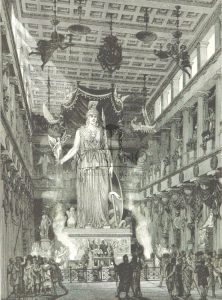 In the enchanting town of Castro lies one of the most extraordinary legacies of Greek and Roman civilization in Italy: the Sanctuary of Minerva, also known as the Athenaion. This legendary site, described by Virgil in the third book of the Aeneid, blends myth and history, culture and spirituality, creating a synergy that recounts centuries of devotion and encounters among Mediterranean peoples. Thanks to archaeological excavations conducted over the last two decades, Castro has regained its prominence as a crossroads of stories, legends, and art, attracting scholars, tourists, and enthusiasts from around the world.
In the enchanting town of Castro lies one of the most extraordinary legacies of Greek and Roman civilization in Italy: the Sanctuary of Minerva, also known as the Athenaion. This legendary site, described by Virgil in the third book of the Aeneid, blends myth and history, culture and spirituality, creating a synergy that recounts centuries of devotion and encounters among Mediterranean peoples. Thanks to archaeological excavations conducted over the last two decades, Castro has regained its prominence as a crossroads of stories, legends, and art, attracting scholars, tourists, and enthusiasts from around the world.
The Connection with Virgil and the Myth of Aeneas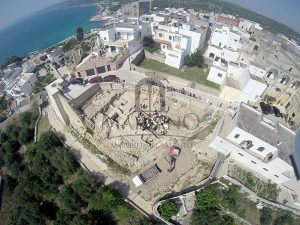
In the Aeneid, Virgil offers a poetic and symbolic depiction of the Sanctuary of Minerva: a temple situated on a promontory, glimpsed by Aeneas and his companions as they seek refuge after the fall of Troy. That promontory, identified by archaeologists as the site of Castro, was not only a guide for sailors but also a spiritual and cultural gateway to Italy. According to the myth, Minerva, the goddess of wisdom and strategy, was venerated here by the Trojans, who saw her as a symbol of hope and renewal.
The port of Castrum Minervae, overlooking the Strait of Otranto, was crucial for maritime routes connecting the Adriatic to the Eastern Mediterranean. This location was not just a landing point but also a crossroads of cultures: from the Greeks to the Messapians and finally the Romans, each civilization left its mark, transforming the sanctuary into a unique center of worship and commerce.
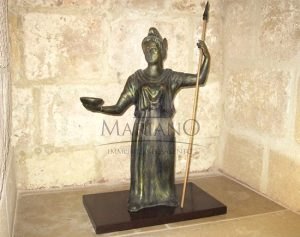 Excavations and Extraordinary Discoveries
Excavations and Extraordinary Discoveries
The rediscovery of the sanctuary was made possible by archaeological excavations initiated in 2007 under the direction of Professor Francesco D’Andria. These investigations uncovered a treasure trove of invaluable artifacts: fragments of ceramics, votive instruments, altars, and, most notably, monumental statues that confirmed Castro’s importance in antiquity.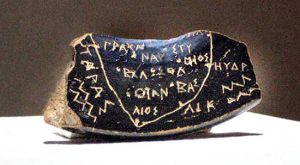
Among the most fascinating finds is a bronze statuette of Athena, unearthed in the early years of the excavations. This statuette, adorned with a Phrygian helmet, symbolically connects the sanctuary with the Trojan myth. The original Messapian settlement, influenced by the 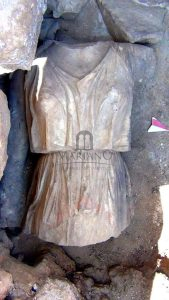 Spartan colony of Taranto, likely predated the Roman renaming of the area as Castrum Minervae. The ancient name of Castro, Lik, is corroborated by the so-called Soleto Map, a black-glazed shard featuring the oldest Western geographical map from classical antiquity, now housed in the National Archaeological Museum of Taranto.
Spartan colony of Taranto, likely predated the Roman renaming of the area as Castrum Minervae. The ancient name of Castro, Lik, is corroborated by the so-called Soleto Map, a black-glazed shard featuring the oldest Western geographical map from classical antiquity, now housed in the National Archaeological Museum of Taranto.
However, it was the discovery of a monumental bust of Athena in 2015 that established Castro as an internationally significant archaeological site. Originally standing over three meters tall, the statue was crafted from Lecce stone, a material typical of Salento known for its easy workability and durability.
In addition to these discoveries, fragments of other statues, including marble feet and decorated bases, were found alongside an altar dating to the 4th century BCE, evidencing animal sacrifices made in Minerva’s honor. These artifacts, along with ceremonial tools and ivory objects, tell of intense religious activity spanning centuries.
The Sanctuary of Minerva: A Beacon of Culture and Spirituality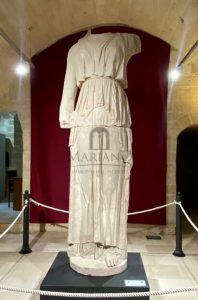
The Sanctuary of Minerva was not only a place of worship but also a symbol of cultural integration. Its strategic position, on a promontory overlooking the sea, made it a landmark for sailors and merchants and a destination for pilgrims from across the Mediterranean. Recognizing its sacred significance, the Romans incorporated the sanctuary into their network of temples, restoring and enriching it with architectural and artistic elements.
The statue of Athena, in particular, is an extraordinary example of Greek art and its influence in Salento. Scholars believe it to be the work of Tarantine sculptors renowned for their expertise in monumental art. The use of Lecce stone also confirms the presence of a highly skilled local network of artisans capable of creating works of great beauty and complexity.
The Museum and the Future of the Archaeological Park
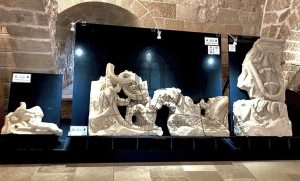 Today, the artifacts unearthed in Castro are preserved in the Archaeological Museum of Castro, housed in the Aragonese Castle. This museum offers visitors a captivating journey through the centuries, showcasing votive artifacts, statue fragments, and a reconstruction of the statue of Athena. In 2019, a replica of the statue was featured in the international exhibition “Gifts of the Gods. L’Apulia Felix between Greeks, Natives, and Romans” in Nanjing, China, earning acclaim and bringing global attention to Salento.
Today, the artifacts unearthed in Castro are preserved in the Archaeological Museum of Castro, housed in the Aragonese Castle. This museum offers visitors a captivating journey through the centuries, showcasing votive artifacts, statue fragments, and a reconstruction of the statue of Athena. In 2019, a replica of the statue was featured in the international exhibition “Gifts of the Gods. L’Apulia Felix between Greeks, Natives, and Romans” in Nanjing, China, earning acclaim and bringing global attention to Salento.
The site’s future is equally promising. With regional and national funding, the archaeological park in Castro will soon be accessible to the public. Visitors will be able to walk among the ruins of the sanctuary and immerse themselves in its history, guided by multimedia paths and virtual reconstructions that recount the sanctuary’s life during the Greek and Roman periods.
A Heritage to Discover and Preserve
The Sanctuary of Minerva in Castro serves as a window to the past, a place where myth and reality converge to narrate Salento’s history as a crossroads of cultures, religions, and peoples. Thanks to the relentless work of archaeologists and institutional support, this site continues to yield discoveries and inspire new research. Visiting Castro today means embarking on a timeless journey, rediscovering the roots of a land that has always stood as a bridge between East and West.



